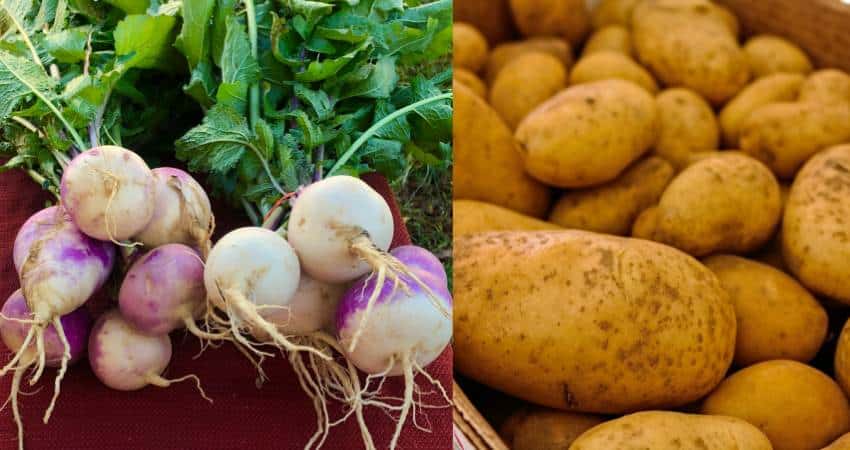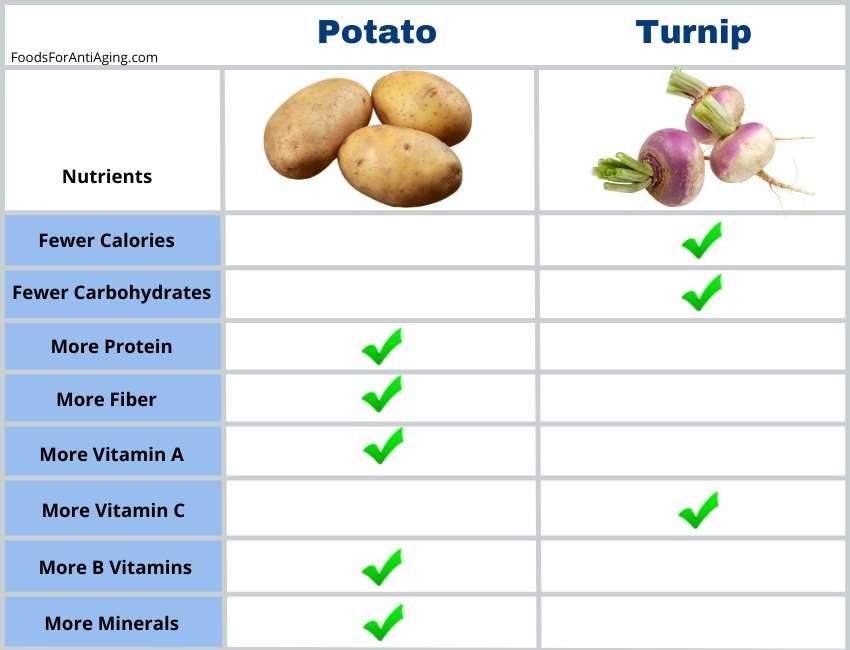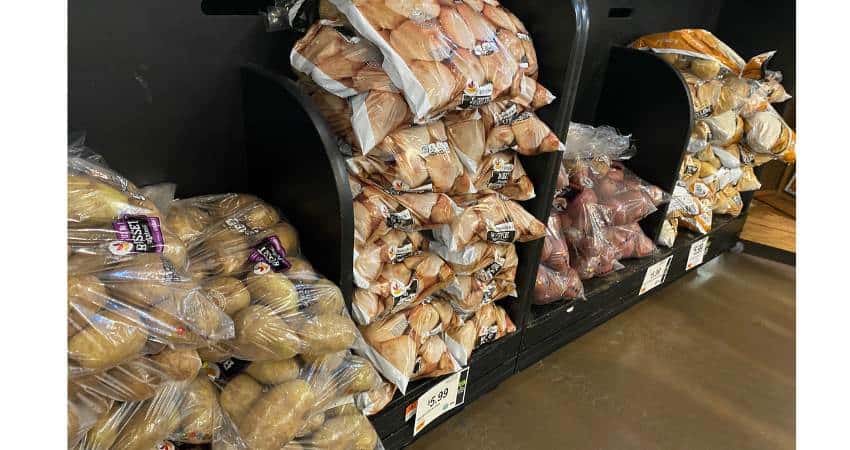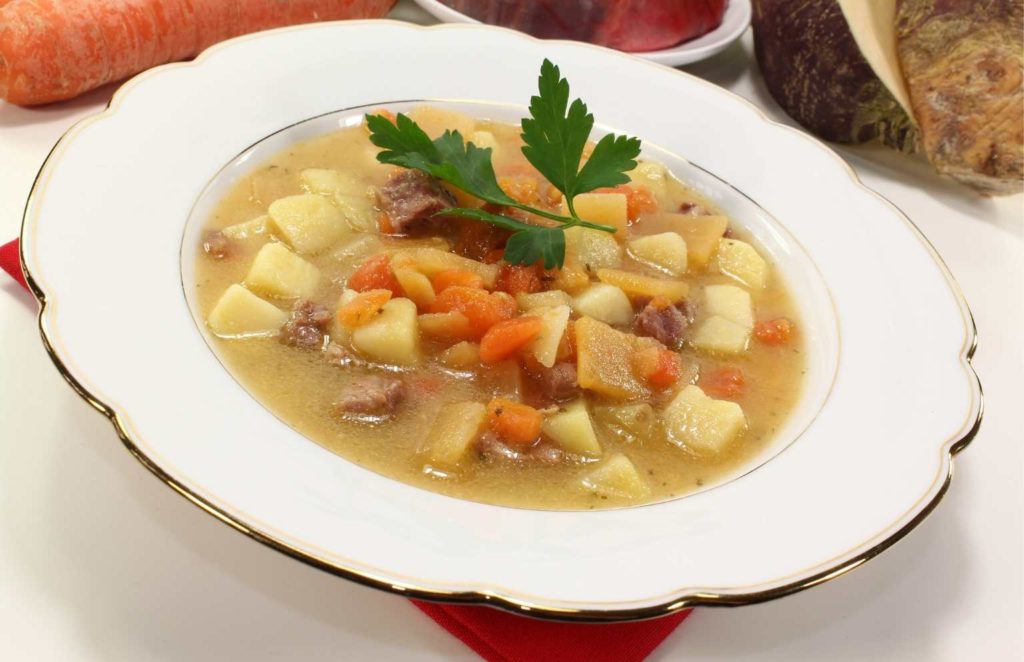Turnip vs. Potato: Are Turnips Better Than Potatoes?
Turnips and potatoes share quite a few similarities which is why many of my health coaching clients ask me about them. Many people wonder about their differences. What’s the difference between a potato and a turnip?
Turnips are the B. rapa species from the Brassicaceae family and potatoes are the S. tuberosum species from the Solanaceae family. Turnips have a white skin with a purple top and a white flesh. Potatoes have a beige to brown skin with a white to yellow flesh. Turnips average 6 inches long and potatoes 3-12 inches.
Other differences:
- Turnips taste sweeter and are less starchier.
- Turnips costs approximately 50% more.
- Turnips contain fewer calories and carbohydrates.
- Potatoes contain a higher percentage of vitamins, fiber and minerals.
This article will include a side-by-side comparison of their nutrients. In addition, I’ll examine their tastes, textures, costs and whether one can substitute for the other. We’ll also take a look at their health benefits and glycemic index.
In addition to coaching clients about them, I’ve purchased, researched and consumed both prior to, during and after writing this article.

Nutritional Difference
There are some nutritional similarities and differences. Therefore, let’s take a look at the nutrients contained in each.
The following table is a side-by-side comparison of the nutrients contained in each one:
| Potato Raw (100 g) | Turnip Raw (100 g) | |
| Calories | 69 | 28 |
| Protein | 1.68 g | 0.90 g |
| Carbohydrates | 15.7 g | 6.4 g |
| Fiber | 2.4 g | 1.8 g |
| Fat | 0.10 g | 0.10 g |
| Sugar | 1.15 g | 3.80 g |
| Vitamin A | 8 IU | 0 IU |
| Beta-carotene | 5 mcg | 0 mcg |
| Vitamin C | 9.1 mg | 21 mg |
| Vitamin B6 | 0.20 mg | 0.09 mg |
| Vitamin B9 (Folate) | 18 mcg | 15 mcg |
| Vitamin B1 (Thiamin) | 0.07 mg | 0.04 mg |
| Vitamin B2 (Riboflavin) | 0.03 mg | 0.03 mg |
| Vitamin B3 (Niacin) | 1.07 mg | 0.40 mg |
| Vitamin B5 (Pantothenic Acid) | 0.28 mg | 0.20 mg |
| Magnesium | 21 mg | 11 mg |
| Phosphorous | 62 mg | 27 mg |
| Potassium | 407 mg | 191 mg |
| Iron | 0.52 mg | 0.30 mg |
| Copper | 0.11 mg | 0.08 mg |
| Calcium | 9 mg | 30 mg |
| Zinc | 0.29 mg | 0.27 mg |
They both contain the same types of nutrients. At first glance it’s difficult to determine which one has the larger nutritional difference. Turnip vs potato, let’s examine if one is healthier than the other.
Potato is healthier than turnips due to its higher percentage of fiber, vitamin A, B vitamins and minerals. It provides more B6, folate, thiamin, niacin, B5, magnesium, phosphorus, potassium, iron, copper and zinc.
Turnips are also healthy and provide a good number of nutrients. They provide a higher percentage of vitamin C and calcium. They contain fewer calories and carbohydrates.
Both contain very little fat. Therefore, your choice may come down to availability, taste preferences or particular goals. let’s take a close look at some of the most common goals people have and decide which one is better for each goal.
Turnip vs Potato: Which To Choose?
Weight Loss and Calories
One such goal may be weight loss. If you’re looking to get rid of some extra fat around the middle, you’ll want to know which one is better for weight loss.
Turnips are better for weight loss due to their lower number of calories and carbohydrates. Turnips contain 140% fewer calories. 100 grams of raw turnips contain 28 calories while potatoes contain 69 calories.
Carbs and Keto Diet
Low carb diets like Keto, require a very low carbohydrate intake. If you’re following a similar diet, you’ll want to know which one has fewer carbs.
Turnip contain fewer carbohydrates than a potato making it better for a low carb diet. They contain more than 50% fewer carbs per 100 grams and net carbs are lower.
Potatoes are higher in starch content and carbs.
Gluten Free
If you have celiac disease or just want to consume a low gluten diet, then this section is for you.
Turnip and potato are gluten free and good for a gluten free diet.
Bodybuilding and Muscle Fitness
If your goal is to gain lean muscle mass and fuel your workouts, you’ll want to know which one of these is higher in protein, calories and carbs.
Potato is better than turnip due to its higher percentage of protein, carbohydrates and calories. The protein is beneficial for building and repairing muscle. The extra carbs help to fuel energy during workouts. The calories may prove beneficial when trying to bulk up.
Similarly, pay attention to how you cook the vegetables and what ingredients you add. While potatoes are healthier overall, you may end up with a less healthy meal if adding traditional toppings like butter, sour cream or bacon.

Taste and Texture
If you cook both foods without any spices, many people wonder if they’d be able to tell the difference between the two. Let’s find out if both foods taste the same and if one is better.
Turnips taste different than potatoes. They have a sweeter flavor and have the spiciness of radishes and the savory taste of cabbage. Potatoes are starchier and earthy with no hint of spice.
If the turnips were harvested when they were older, you may get a slightly bitter flavor. Some people find them tasting like a cross between a spud and a carrot.
When a potato is baked or fried, it gets a golden, crispy crust with a pillowy inside. It gets very soft when boiled, so people love turning it into silky smooth mashed.
To conduct some original research, I polled clients, readers and members of food groups I belong to. I asked them which of the two foods taste better.
- 36% said they preferred the taste of a turnip.
- 55% said they preferred the taste of a potato.
- 9% said they had no preference.
To conduct more original research, I set up a taste test at home. Both were prepared as mashed and floored the same way. The potatoes were chosen more often.
Find out how bread compared for health and nutrients in my article.
Substitutions
There are times when only one of the two is available or you don’t want to run out to the store. In these situations you’ll wonder if you can substitute one for the other.
Turnips and potatoes can substitute for each other although the taste and texture will differ. They both can be used in the same recipes requiring boiling, baking, frying, soup, stews or mashing. Both can substitute for each other using the same weight called for in a recipe.
Alternatives
If you’re looking for alternatives, there are quite a few healthy options you can go with:
- Rutabagas. Rutabagas are vegetables containing the turnip and wild cabbage genes. They are bigger and generally taste better.
- Parsnips. This vegetable is a cross between carrots and parsnips and (in my opinion) tastes great.
- Celery Root. This is an interesting member of the parsley family. The crisp celery-parsley flavor makes it an excellent vegetable to eat raw, cooked or baked.
- Carrots. Carrots are the tastiest alternative. You can eat them raw or cook them for the same soft feel you’d get from potatoes and turnips.
Cooking Time
Turnips take slightly longer to cook in most dishes. However, you can reduce the cooking time by slicing them thinner.
Cooking one inch turnip cubes will take around 15-20 minutes. If you’re looking to roast them in the oven, you’ll need to wait 20-30 minutes.
On the other hand, potatoes will take 10-20 minutes to become soft, no matter whether you boil them or roast them in the oven.
In turnip rich recipes, try adding almond milk to the mashed type to add healthy fat. You can’t go wrong serving them with roasted vegetables on the side.
Find out if rice has more nutrients in my article here.
Costs
With the rising prices of just about everything, the cost of something certainly matters to most. The price may sway your decision about which food to use. Therefore, let’s examine which one costs more.
Turnips cost more than potatoes. The average price for turnips is $0.99 per pound. The average price for turnips is $1.46 per pound.
To conduct some original research, I conducted a search for the prices of each food in some of my local supermarkets.
I first visited the Shoprite supermarket and found the following:
- Turnips
- $1.44 per pound
- Potatoes
- $0.99 per pound
I then checked Walmart:
- Potatoes
- $0.99 per pound
Find out how cassava compared in my comparison article.

How To Store Turnips and Potatoes
Whichever you choose or have on hand, proper storage is crucial. How you store them can affect how long they last before going bad and how they taste when cooked.
As a Certified Health Coach I conduct pantry makeovers which sometimes include food storage.
These two foods come up often during my sessions. Therefore, let’s examine how to store both foods.
Store potatoes in a dark, cool place away from heat and do not store them in the refrigerator. A humid basement or root cellar is the best area. They should be kept in a burlap bag or ventilated container and stored between 40°F and 60°F.
Storing them in a refrigerator can make the center hard and change the cell structure. This can diminish the flavor. If you don’t have a cool basement, store them in a ventilated place, away from heat and light.
How do you store a turnip?
- Remove the turnip greens and wipe off any soil.
- Cover it in a damp cloth.
- Place it into a ventilated container.
- Store turnips in the refrigerator’s crisper drawer.
- Store up to 4 to 5 months.
To find out what the difference to taro check out my article here.

Glycemic Index and Diabetes
Knowing the glycemic index of food is important especially if you’re diabetic or blood sugar levels are a concern. Avoiding blood sugar spikes is an important part of consuming healthy food.
The Glycemic Index (GI) is a scale measuring how fast a particular food raises the blood sugar in the blood3. Blood sugar spikes can lead to health complications with the heart, nerves, kidneys and eyes4.
Foods on the GI scale are categorized as:
- Low-GI foods: 55 or under
- Medium-GI foods: 56-69
- High-GI foods: 70 or over
How blood sugars levels are affected:
- Foods with a glycemic index 70 or more cause a quicker spike in blood sugar levels.
- Foods with a glycemic index 56 to 69 cause a moderate spike in blood sugar levels.
- Foods with a glycemic index 55 or less cause a slow spike in blood sugar levels.
Now we know what the glycemic index is, and how it affects blood sugar, let’s examine which one has a higher GI?
Turnips have a similar GI when compared to Russet and Yukon Gold potatoes. Turnips have a GI of 62, a boiled russet has a GI of 54 and a boiled Yukon Gold has a GI of 58. Turnips are considered a medium GI food.
All spuds have different GI scores. In addition to how a it is cooked, the heat when eaten affects the GI.
A study published in the Journal of the Diabetic Association found boiled potatoes eaten cold had a GI score of 56. When eaten hot it had a GI score of 895.

Potato and Turnip Health Benefits
As noted in the nutrient section of this article, the nutrients provided by both have many health benefits. They have dramatically different mineral contents.
Let’s examine how each one of these nutrients benefit health issues.
Fiber
A potato has 2.4 grams per 100 gram serving. They both contain soluble and insoluble fiber. Fiber remains in the digestive tract and provides gut related health benefits. Fiber rich diets have been linked to regular bowel movements and a lower risk of colon cancer6.
Potassium
A potato provides, 407 mg per 100 grams raw. Potassium helps the body get rid of excess sodium reducing fluid build-up. These help keep systolic and diastolic blood pressure lower ((American Heart Association: How Potassium Can Help Control High Blood Pressure)).
According to Harvard Health, a number of studies have shown a connection between low potassium levels and high blood pressure7. The more potassium, the more sodium your body will lose.
Consuming too much sodium or not enough potassium throws off the delicate balance the kidneys need to remove the excess water8.
Calcium
Turnips provide 30 grams of calcium per 100 grams.
Calcium is important for the heart and blood pressure. Harvard Health reports calcium helps maintain blood pressure by helping in the controlling of the relaxing and tightening of blood vessels9.
The calcium in a turnip also helps the following:
- Helps muscles function properly.
- Helps nerve function.
- Build and maintain strong bones.
Magnesium
A potato provides 21 mg per 100 grams. Magnesium helps keep blood pressure levels stable and balanced. Recent scientific research examined previous studies and concluded magnesium supplementation decreased systolic and diastolic blood pressure10.
Magnesium helps control the following:
- Blood sugar
- Blood pressure
- Insomnia
- Muscle
- Nerve function
One reason many people supplement with magnesium in the evening is because it helps calm the whole body including blood vessels.
In the heart and muscles, magnesium competes with calcium to help the muscles relax after contracting. When the body is low in magnesium, calcium can over stimulate the heart muscle’s cells causing a rapid or irregular heartbeat ((National Institutes of Health: Magnesium)).
If you’re interested about how sweet potatoes held up against pumpkin for health and nutrition, check out my article, Pumpkin vs Sweet Potato: A Complete Comparison.
Vitamins
B Vitamins
The B vitamins provided include the following:
- B1 (thiamin)
- B2 (riboflavin)
- B3 (niacin)
- B5
- B6
- B9 (folate)
B vitamins help support the following:
- Red blood cells.
- Brain function.
- Nerve function.
- Cardiovascular disease.
- Digestion.
- Energy levels.
A lack of B vitamins has been associated with oxidative stress and neural inflammation. In a study released in 2018 32 healthy adults were given B vitamin supplementation for six months. The results indicated preliminary evidence B vitamin supplementation reduced oxidative stress and inflammation11.
Vitamin C
A turnip has significantly more vitamin C than potatoes. The body can’t make vitamin C, so it must come from the foods ate every day.
Vitamin C has been shown in studies to help with the growth and repair of tissues throughout the body12.
Vitamin C helps heal and repair wounds, maintain healthy bones, skin and cartilage. Vitamin C acts as an antioxidant and fights free radicals which damage the cells. Helping to prevent cell damage can help with the following:
- Heart disease.
- Certain diseases like cancer.
- Promote healthy aging.
If you have any questions about this article don’t hesitate to email us. You can find an email on our contact page.
What are Turnip Greens?
Turnip greens are the green leafy tops of the turnip. The greens are edible, add flavor to recipes and contain vitamins, minerals and provide their own health benefits.
Read Next – More Food Articles!
Red Potatoes vs Yukon Gold Potatoes: What’s The Difference?
Sweet Potato vs. Butternut Squash: A Comparison
Are Sweet Potatoes Healthier Than Regular Potatoes?
Plantain vs Potato – Which is Better? Let’s Compare
- USDA: Turnips, raw [↩]
- USDA: Potatoes, white, flesh and skin, raw [↩]
- Harvard Health Publishing: Glycemic index for 60+ foods [↩]
- National Institute of Diabetes and Digestive and Kidney Diseases: Know Your Blood Sugar Numbers: Use Them to Manage Your Diabetes [↩]
- National Center for Biotechnology Information: Glycemic index of potatoes commonly consumed in North America [↩]
- National Center for Biotechnology Information: Mechanisms linking dietary fiber, gut microbiota and colon cancer prevention [↩]
- Harvard Health: Potassium lowers blood pressure [↩]
- National Center for Biotechnology Information: The Effect of the Sodium to Potassium Ratio on Hypertension Prevalence: A Propensity Score Matching Approach [↩]
- Harvard Health: Key minerals to help control blood pressure [↩]
- National Center for Biotechnology Information: Effect of magnesium supplementation on blood pressure: a meta-analysis [↩]
- National Center for Biotechnology Information: The Effect of a High-Dose Vitamin B Multivitamin Supplement on the Relationship between Brain Metabolism and Blood Biomarkers of Oxidative Stress: A Randomized Control Trial [↩]
- National Center for Biotechnology Information: Vitamin C and Immune Function [↩]
